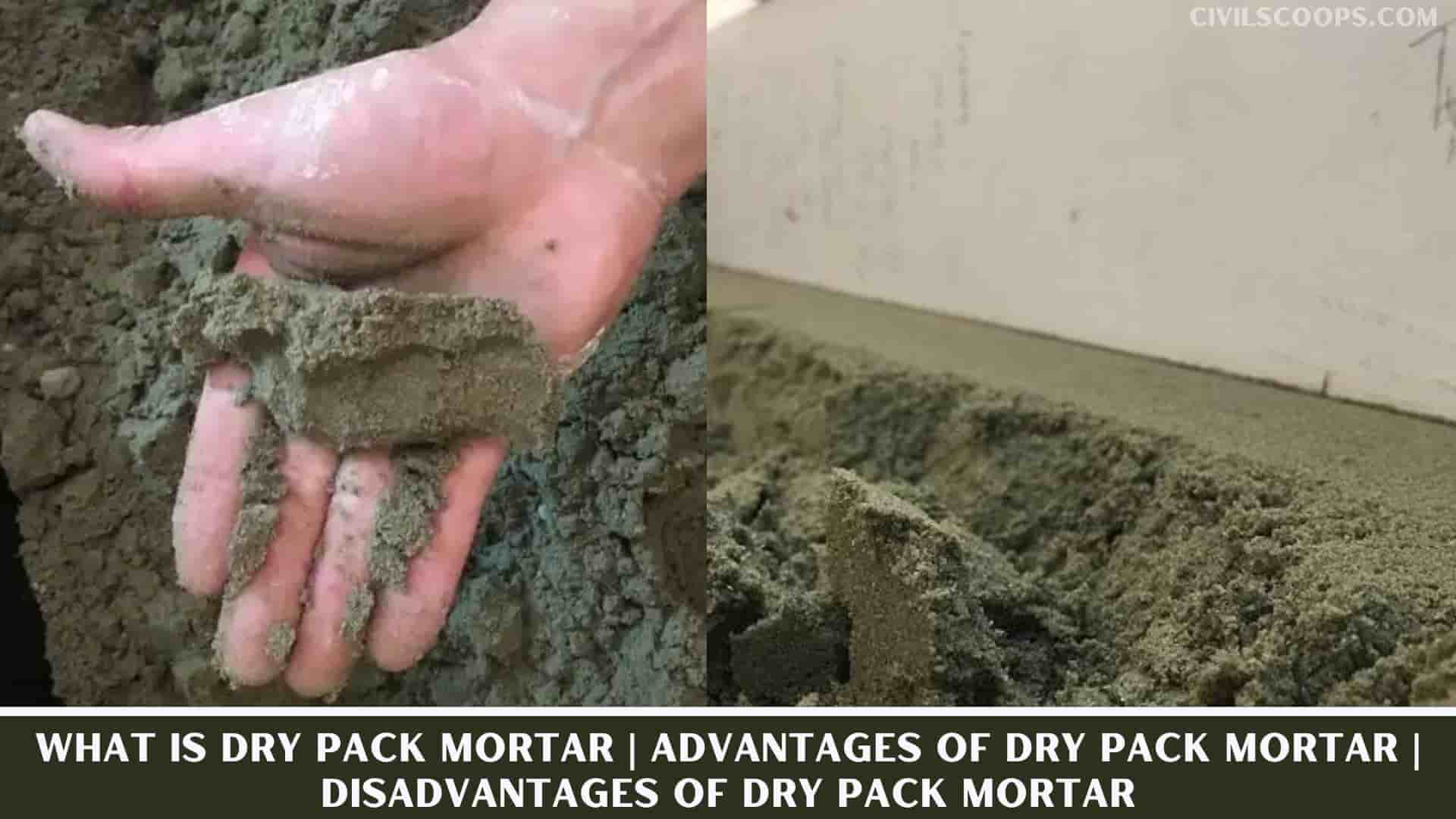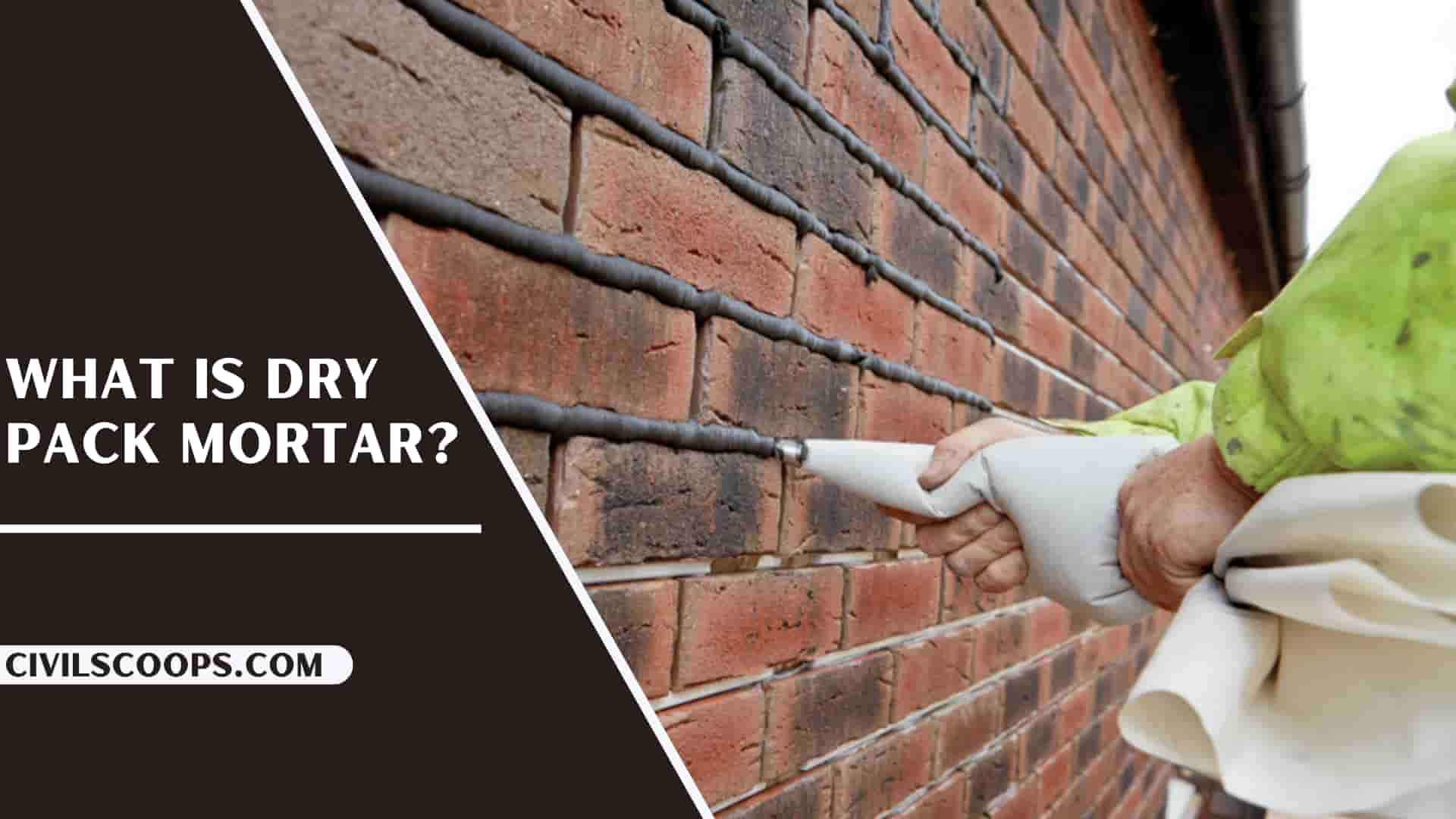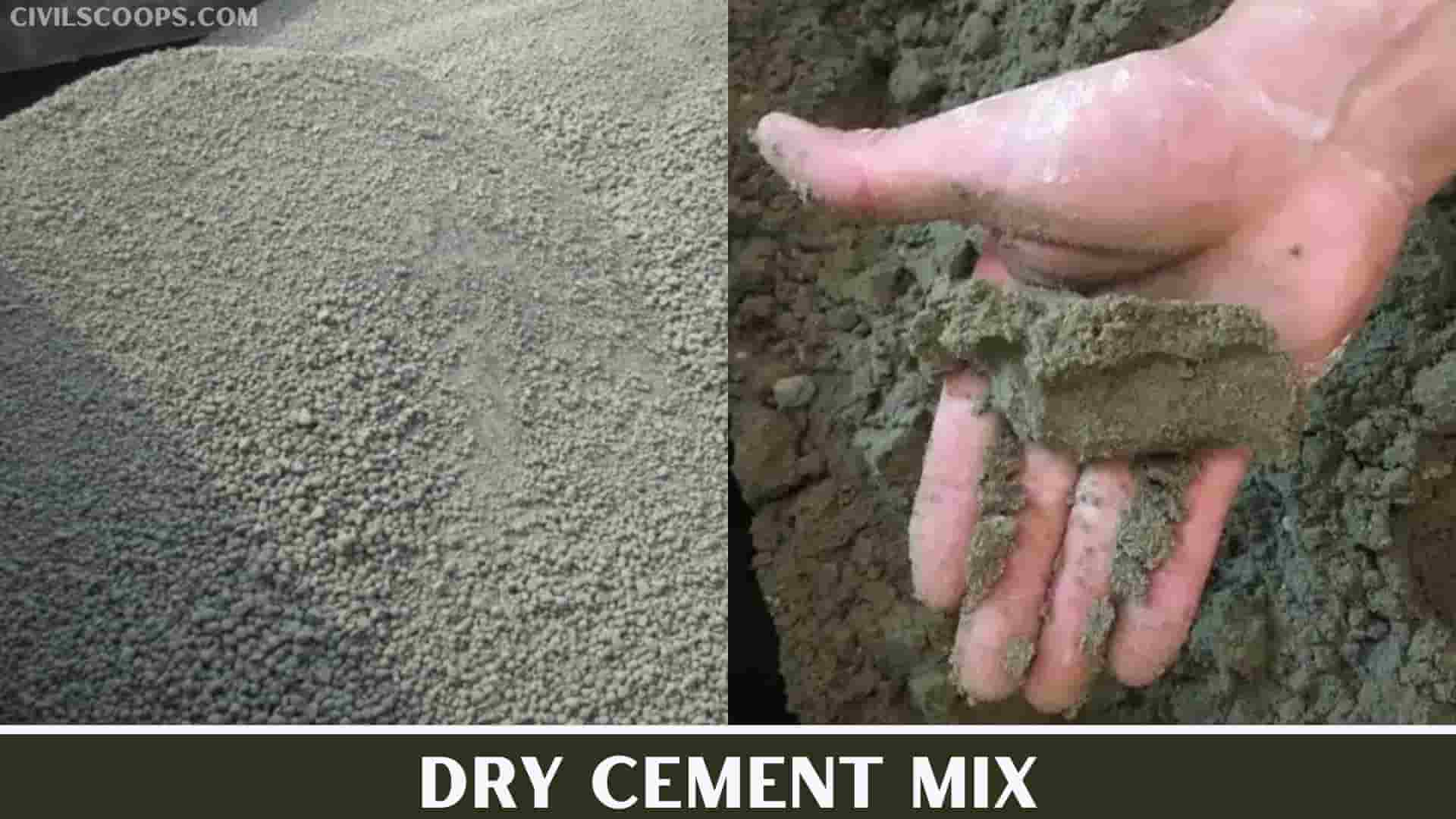What Is Dry Pack Mortar | Advantages of Dry Pack Mortar | Disadvantages of Dry Pack Mortar

Table of Contents
Introduction of Dry Pack Mortar
Dry pack mortar is simply a mixture of cement, sand, and water in the appropriate proportion. Dry pack mortar is also known as deck mud or floor mud.
Dry pack mortar is used for repairing the concrete cracks and filling up the deep holes in the concrete.
What Is Dry Pack Mortar?

Dry pack mortar is nothing but a stiff mortar that consists of three ingredients such as cement, sand, and water. It is widely used for repairing small areas and filling holes and cracks in buildings.
Dry Mortar Mix Proportion
The mix proportion for making dry pack mortar which is generally used, is one part of cement and four-part of sand. The sand which is used for dry pack mortar should be clean and free from dust particles.
The mix proportion for dry mix mortar that can be used is 1:3 and 1:5. The mix proportion of dry mortar mix depends upon the purpose for which it is used.
The water used in the dry mix mortar should be potable and free from salts. An adequate amount of water should be added to a dry mortar mix such that it can produce a mortar that can stick together and can be molded into the ball with the help of hands.
Preparation of Dry Pack Mortar for Repairing of Concrete.
The steps which are carried out for repairing concrete cracks and other small areas are as follows:-
- Surface Preparation.
- Preparation of Dry pack Mortar.
- Application of dry pack mortar.
- Curing of dry pack mortar.
1. Surface Preparation
It is necessary that before applying dry pack mortar, the surface should be properly clean and free from any dust particles.
There should be small holes drilled on the surface with the help of a chisel; it will create a good bond when dry pack mortar is applied. Sprinkle water on the surface where dry pack mortar will be applied.
The surface should be rough enough so that dry pack mortar can develop a strong bond with it.
2. Preparation of Dry Pack Mortar
The Dry Pack mortar is made from a mixture of cement, sand, and water in an appropriate proportion. Generally, the mix proportion of 1:3 and 1:4 is used for repairing concrete and filling the holes and cracks. It means one part of cement and three or four-part of sand.
Sand should be clean and free from dust particles. Water Should be added adequately because extra water can lead to shrinkage and also reduce the strength. The Dry pack mortar should be mixed properly so that it can be crumbled into a ball.
3. Application of Dry Pack Mortar
Before applying dry pack mortar, it should be mixed properly. It should be applied on the required surface with a maximum thickness of 10 mm for each layer.
The grooves should be provided on the surface so that there should be a good bond that will be developed with each layer. The proper compaction should be done so that there would not be any pores developed in it.
4. Curing of Dry Pack Mortar
It is very essential that the proper curing will be done of dry mortar mix for about 15 days. The care should be taken that dry pack mortar should be kept wet by proper curing on it. Curing will help to develop its strength in it and makes it durable.
Advantages of Dry Pack Mortar:
- Dry pack mortar is time-saving and economical.
- It can be used for internal as well as external plaster.
- It helps to create a consistent mix for the large project work.
- The job site mixing of cement and sand is no longer needed.
- Dry pack mortar can be tamped, compacted, and molded in any shape easily.
- Dry pack mortar gives a uniform and better finish to the surface on which it is applied.
- It has enhanced durability and workability.
- It is used for repairing concrete cracks and holes in the concrete.
Disadvantages of Dry Pack Mortar:
- There may be chances of shrinkage in the dry pack mortar.
- If it is not mixed properly, then it will not develop a strong bond with the surface.
- Dry pack mortar cannot be used for major repairing work and filling major cracks.
- It is only suitable for work where less thickness is required.
Dry Cement Mix

Dry pack mortar is basically a combination of cement and fine sand which passes through sieve no 16 and is thoroughly mixed with water to hydrate the cement.
Dry Cement mortar is used for filling holes having a depth equal to or greater than the least surface dimension of the repair area. For the dry-pack method of concrete repair, the holes are required to be sharp and square at the surface edges. Other holes should be undercut slightly in several places around the perimeter. Holes for dry packs should have a minimum depth of 1 inch.
Applications of Dry Pack Mortar
- Dry pack mortar is used for both residential as well as commercial applications.
- Dry pack mortar is used to prepare thick mortar beds.
- It can be used as a waterproofing membrane to prevent leakages.
- It is also used in tile installation and brick placement.
- Dry pack Mortar is used to level the concrete beds.
- It is also widely used for floating shower bases and floors.
- Dry pack mortar is mainly used for filling holes in concrete floors and walls.
- Dry cement mortar is used to fill the crack between the pavers.
- It is used for repairing cracks in concrete surfaces.
- It is also used in external as well as internal applications.
- It is also used to give a uniform finish to the concrete surface.
Dry Pack Mortar for the Installation of Tiles
Step 1: Firstly, prepare the dry pack mortar with one part of Portland cement and three-part of fine sand. Add an adequate amount of water to it and mix it thoroughly.
Step 2: Spread the tile glue to the floor and then apply dry pack mortar mixture on the floor with a uniform layer.
Step 3: Apply a skim coat on the top layer of the dry pack. Dry pack mortar is used to level the floor for tile installation. Dry pack mortar also ensures the durability of your tiles.
Step 4: Apply tiles on the dry pack mortar and tap it gently to fix it properly. If the floor has deep crevices, the dry pack mortar will even out the floor. You will compensate for dips and unevenness with the help of dry pack mortar.
Step 5: Allow it to dry for 24 hours. Do not permit any heavy load on it. The dry pack mortar gets cured with time and dried.
[su_box title=”FAQ” style=”default” box_color=”#333333″ title_color=”#FFFFFF” radius=”3″ class=”” id=””]
Dry Pack
Dry pack mortar, which is also called deck mud or floor mud, is a mixture of sand, cement, and water. It is used to repair small spots, creating thick bed mortar for tile and brick placement, and bed shower installation.
What Is Dry Pack Mortar?
Dry pack mortar is a stiff sand-cement mortar that is typically used to repair small areas that are deeper than they are wide. Place and pack the mortar in layers to a compacted thickness of about 3/8 inch.
Dry Mortar Mix Proportion
For a standard mortar mix, this is normally on a ratio basis (usually around 3 or 4 parts building sand to 1 part cement). Recommendations vary – but you don’t want the mixture to be too wet or too dry.
Dry Pack Mortar for Repairing Concrete
According to the Bureau of Reclamation’s Guide to Concrete Repair, dry pack mortar contains (by dry volume or weight) one part cement, 2 1/2 parts sand, and enough water to produce a mortar that will just stick together while being molded into a ball with the hands.
What Is Drypack Mortar?
Dry pack mortar is a stiff sand-cement mortar that is typically used to repair small areas that are deeper than they are wide. Compact the mortar in the hole by striking a hardwood dowel or stick with a hammer. The sticks are usually about eight to 12 inches long and no more than one inch in diameter.
Tile Mortar Mix Ratio
A roof tile mortar mix should have a ratio of 1-part cement, two parts building sand, and 1-part wash sand. Alternatively, you may choose to employ a ratio of 1-part cement and three parts of building sand. You will need water to complete your mixture.
Dry Pack Ratio Cement Sand
Mixture Proportion
It is reported that one part of cement to four parts of sand, preferably sharp clean sand, is adequate. However, mix proportions like one to two and a half, and one to five or even six are reported.
Dry Pack Mortar Ratio
The mix proportion for making dry pack mortar which is generally used is one part of cement and four-part of sand. The sand which is used for dry pack mortar should be clean and free from dust particles.
Mortar Mix for Paving
The best mix for pointing patios is ideal at a ratio of 1:4 – one part concrete and four parts sharp sand. In some cases, you can use 1:3, but that’s only really going to help when you’re pointing.
Dry Pack Vs Wet Concrete
Dry mix concrete involves getting all the dry materials in bags, and then water is added directly on the site through a delivery hose and applied. Wet mix, on the other hand, as the name suggests is a complete mix that usually needs to be stored in concrete trucks and added directly to the site.
[/su_box]
[su_note note_color=”#F2F2F2 ” text_color=”#333333″ radius=”3″ class=”” id=””]
Like this post? Share it with your friends!
Suggested Read –
- 15 Different Types of Cement and Their Uses
- Difference Between Timber And Wood | What is Wood | What is Timber
- What Is Sealing Brick Work| Advantages of Brick Sealer | Types of Brick Sealer
- Stepped Footing | House Foundation on Slope | How to Build a Foundation on the Slope
- What Is Weirs | Types of Weirs | Advantages & Disadvantages of Weirs | Operation & Limitations For Weir | Limitations of Weirs | Location of Weirs
[/su_note]
Originally posted 2022-09-09 11:42:02.
